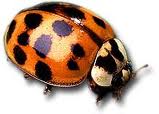Biting Asian ladybugs Ottawa
Carleton University entomologist Jeff Dawson said in the fall the ladybug looks for places with stable temperatures to survive the winter.
Often, they sneak into cracks and open holes in people's homes. The insects also do not face much threat in their natural habitats.
"Being an introduced species, they tend not to have the same predators," said Dawson," So their numbers tend to explode at certain times of year."
The pretty, yellowish-orange bug has been spotted in the small community of Winchester, Ont., just south of Ottawa, at Carleton University and even at a south Ottawa golf course.
This insect has popped up in Ontario before, though. In 2001, some vintage Ontario wines faced a plague of the insects, which led to the smell of Asian ladybugs polluting the wines — an aroma compared to "rancid peanut butter."
The Asian ladybug was first brought to North America by the U.S. government from Japan in 1988 to serve as an aggressive species for insect control.
The checker spot ladybug was also brought over from Europe in the 1960s for insect control. There are even reports the foreign insects are threatening native ladybugs.
Dawson said an Asian ladybug's bite is usually a surprise for local residents who do not expect the insects to be aggressive. As for the invasion, he said it likely would not be permanent.
"We don't have to fear the invasion. Over time, the number should decrease," he said.
Dawson added the best way to eliminate the Asian ladybug is by using warm, soapy water where they have gathered.
Source: yahoo










